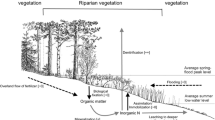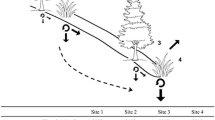Abstract
Patterns of nitrogen (N) accumulation and turnover in riparian systems in semi-arid regions are poorly understood, particularly in those ecosystems that lack substantial inputs from nitrogen fixing vegetation. We investigated sources and fluxes of N in chronosequences of riparian forests along the regulated Green River and the free-flowing Yampa River in semi-arid northwestern Colorado. Both rivers lack significant inputs from N-fixing vegetation. Total soil nitrogen increased through time along both rivers, at a rate of about 7.8 g N m−2 year−1 for years 10–70, and 2.7 g N m−2year−1 from years 70–170. We found that the concentration of N in freshly deposited sediments could account for most of the soil N that accumulated in these floodplain soils. Available N (measured by ion exchange resin bags) increased with age along both rivers, more than doubling in 150 years. In contrast to the similar levels of total soil N along these rivers, N turnover rates, annual N mineralization, net nitrification rates, resin-N, and foliar N were all 2–4 times higher along the Green River than the Yampa River. N mineralization and net nitrification rates generally increased through time to steady or slightly declining rates along the Yampa River. Along the Green River, rates of mineralization and nitrification were highest in the youngest age class. The high levels of available N and N turnover in young sites are not characteristic of riparian chronosequences and could be related to changes in hydrology or plant community composition associated with the regulation of the Green River.




Similar content being viewed by others
References
Aber JD, Melillo JM (1991) Terrestrial ecosystems. Saunders College, Orlando, Florida
Ambus P, Mosier A, Christensen S (1992) Nitrogen turnover rates in a riparian fen determined by N−15 dilution. Biol Fertil Soils 14:230–236
Baumgardner RE, Lavery TF, Rogers CM, Isil SS (2002) Estimates of the atmospheric deposition of sulfur and nitrogen species: clean air status and trends network, 1990–2000. Environ Sci Technol 36:2614–2629
Binkley D, Hart SC (1989) The components of nitrogen availability assessments in forest soils. Adv Soil Sci 10:57–112
Binkley D, Suarez F, Stottlemyer R, Caldwell B (1997) Ecosystem development on terraces along the Kugururok River, Northwest Alaska. Ecoscience 4:311–318
Boggs K, Weaver T (1994) Changes in vegetation and nutrient pools during riparian succession. Wetlands 14:98–109
Brunet RC, Astin KB (1996) Variations in mineral nitrogen levels: the River Adour. Hydrobiologia 335:159–170
Brunet RC, Astin KB (2000) A 12-month sediment and nutrient budget in a floodplain reach of the River Adour, Southwest France. Regul Rivers-Res Manage 16:267–277
Brunet RC, Pinay G, Gazelle F, Roques L (1994) Role of the floodplain and riparian zone in suspended matter and nitrogen retention in the Adour River, South-West France. Regul Rivers-Res Manage 9:55–63
Busch DE, Smith SD (1995) Mechanisms associated with decline of woody species in riparian ecosystems of the southwestern US. Ecol Monogr 65:347–370
Chapin FS, Walker LR, Fastie CL, Sharman LC (1994) Mechanisms of primary succession following deglaciation at Glacier Bay, Alaska. Ecol Monogr 64:149–175
Cooper DJ, Merritt DM, Andersen DC, Chimner RA (1999) Factors controlling the establishment of Fremont cottonwood seedlings on the Upper Green River, USA. Regul Rivers-Res Manage 15:419–440
Craft CB, Casey WP (2000) Sediment and nutrient accumulation in floodplain and depressional freshwater wetlands of Georgia, USA. Wetlands 20:323–332
Ellis LM, Crawford CS, Molles MC (1998) Comparison of litter dynamics in native and exotic riparian vegetation along the Middle Rio Grande of Central New Mexico, USA. J Arid Environ 38:283–296
Everitt BL (1998) Chronology of the spread of Tamarisk in the Central Rio Grande. Wetlands 18:658–668
Fisher RF, Binkley D (eds) (2000) Ecology and management of forest soils. Wiley, New York
Grams PE, Schmidt JC (2002) Streamflow regulation and multi-level floodplain formation: channel narrowing on the aggrading Green River in the eastern Uinta Mountains, Colorado and Utah. Geomorphology 44:337–360
Gregory SV, Swanson FJ, Mckee WA, Cummins KW (1991) An ecosystem perspective of riparian zones. Bioscience 41:540–551
Groffman PM, Gold AJ, Jacinthe PA (1998) Nitrous oxide production in riparian zones and groundwater. Nutr Cycling Agroecosyst 52:179–186
Hobbie EA, Macko SA, Shugart HH (1998) Patterns in N dynamics and N isotopes during primary succession in Glacier Bay, Alaska. Chem Geol 152:3–11
Junk WJ (1999) The flood pulse concept of large rivers: learning from the tropics. Arch Hydrobiol 3:261–280
Kaye JP, Binkley D, Rhoades CC (2003) Non-labile soil nitrogen accumulation and flexible organic matter stoichiometry during primary floodplain succession. Biogeochemistry 63:1–22
Klingensmith KM, VanCleve K (1993a) Denitrification and nitrogen fixation in floodplain successional soils along the Tanana River, Interior Alaska. Can J For Res 23:956–963
Klingensmith KM, Vancleve K (1993b) Patterns of nitrogen mineralization and nitrification in floodplain successional soils along the Tanana River, Interior Alaska. Can J For Res 23:964–969
Lichter J (1998) Primary succession and forest development on coastal Lake Michigan sand dunes. Ecol Monogr 68:487–510
Matthews JA (1992) The ecology of recently deglaciated terrain: a geoecological approach to glacier forelands and primary succession. Cambridge University Press, Cambridge
Merritt DM (1997) Riparian vegetation and geomorphic features on regulated and unregulated rivers: Green and Yampa, NW Colorado. MS Thesis. Colorado State University, Fort Collins, Colorado
Merritt DM Cooper DJ (2000) Riparian vegetation and channel change in response to river regulation: a comparative study of regulated and unregulated streams in the Green River Basin, USA. Regul Rivers-Res Manage 16:543–564
Molles MC, Crawford CS, Ellis LM, Valett HM, Dahm CN (1998) Managed flooding for riparian ecosystem restoration—managed flooding reorganizes riparian forest ecosystems along the Middle Rio Grande in New Mexico. Bioscience 48:749–756
Nadelhoffer KJ, Aber JD, Melillo JM (1983) Leaf-litter production and soil organic matter dynamics along a nitrogen availability gradient in southern Wisconsin (USA). Can J For Res 13:12–21
NADP (2002) National Trends Network http://nadp.sws.uiuc.edu/ Cited on 5/22/02
Pastor J, Aber JD, McClaugherty CA, Melillo JM (1984) Above-ground production and N and P cycling along a nitrogen mineralization gradient on Blackhawk Island, Wisconsin. Ecology 65:256–268
Pinay G, Ruffinoni C, Fabre A (1995) Nitrogen cycling in 2 riparian forest soils under different geomorphic conditions. Biogeochemistry 30:9–29
Pinay G, Decamps H, Naiman RJ (1999). The spiralling concept and nitrogen cycling in large river floodplain. Arch Hydrobiol 3:281–291
Poff N L, Allan JD, Bain MB, Karr JR, Prestegaard KL, Richter BD, Sparks RE, Stromberg JC (1997) The natural flow regime. Bioscience 47:769–784
Schade JD, Marti E, Welter JR, Fisher SG, Grimm NB (2002) Sources of nitrogen to the riparian zone of a desert stream: implications for riparian vegetation and nitrogen retention. Ecosystems 5:68–79
Scott ML, Auble GT, Friedman JM (1997) Flood dependency of cottonwood establishment along the Missouri River, Montana, USA. Ecol Appl 7:677–690
Sollins P, Glassman CA, and Dahm CN (1985) Composition and possible origin of detrital material in streams. Ecology 66:297–299
Steiger J, Gurnell AM (2002) Spatial hydrogeomorphological influences on sediment and nutrient deposition in riparian zones: observations from the Garonne River, France. Geomorphology 49:1–23
Stromberg JC, Patten DT, Richter BD (1991) Flood flows and dynamics of Sonoran riparian forests. Rivers 2:221–235
Tabacchi E, Correll DL, Hauer R, Pinay G, Planty-Tabacchi AM, Wissmar RC (1998) Development, maintenance and role of riparian vegetation in the river landscape. Freshwater Biol 40:497–516
Tremolieres M, Sanchez-Perez JM, Schnitzler A, and Schmitt D (1998) Impact of river management history on the community structure, species composition and nutrient status in the Rhine alluvial hardwood forest. Plant Ecol 135:59–78
United States Geological Survey (1973–1994) Data from Selected U.S. Geological Survey National Stream Water-Quality Monitoring Networks. USGS Digital Data Series DDS−37. http://wwwrvares.er.usgs.gov/wqn96 cd/html/wqn/wq/region14 . Station 09251000, Yampa River near Maybell, Colorado and station 09234500, Green River near Greendale, Utah
VanCleve K, Dyrness CT, Marion GM, Erickson R (1993a) Control of soil development on the Tanana River floodplain, Interior Alaska. Can J For Res 23:941–955
VanCleve K, Yarie J, Erickson R, Dyrness CT (1993b) Nitrogen mineralization and nitrification in successional ecosystems on the Tanana River floodplain, Interior Alaska. Can J For Res 23:970–978
VanCleve K, Viereck LA, Dyrness CT. (1996) State factor control of soils and forest succession along the Tanana River in Interior Alaska, USA. Arct Alp Res 28:388–400
Vought LBM, Dahl J, Pedersen CL, Lacoursiere JO (1994) Nutrient retention in riparian ecotones. Ambio 23(6):342–348
Walker LR (1989) Soil nitrogen changes during primary succession on a floodplain in Alaska, USA. Arct Alp Res 21:341–349
Ward JV, Stanford JA (1995) Ecological connectivity in alluvial river ecosystems and its disruption by flow regulation. Regul Rivers-Res Manage 11:105–119
Williams CA (2000) A comparison of floodplain hydrology and cottonwood water relations on a regulated and an unregulated river in Northwestern Colorado. MS Thesis. Colorado State University, Fort Collins, Colo.
Acknowledgements
We thank Regan Dunn and Ryan Mitchell for invaluable help in the laboratory and field, and David Cooper for stimulating discussions about the geomorphology and development of these sites. This research was funded by the US Geological Survey Biological Resources Division, and by McIntire-Stennis appropriations to Colorado State University. Our work was also supported and encouraged by the staff at Browns Park National Wildlife Refuge, Dinosaur National Monument, and the owners and managers of the Cross Mountain Ranch.
Author information
Authors and Affiliations
Corresponding author
Rights and permissions
About this article
Cite this article
Adair, E.C., Binkley, D. & Andersen, D.C. Patterns of nitrogen accumulation and cycling in riparian floodplain ecosystems along the Green and Yampa rivers. Oecologia 139, 108–116 (2004). https://doi.org/10.1007/s00442-004-1486-6
Received:
Accepted:
Published:
Issue Date:
DOI: https://doi.org/10.1007/s00442-004-1486-6




